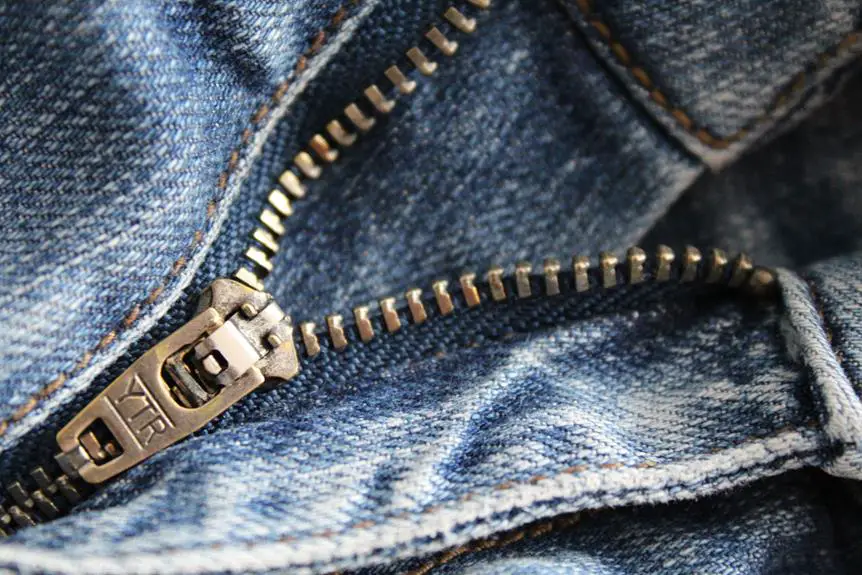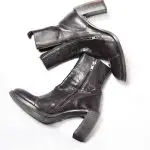Do you wonder if the YKK zip is the ultimate fabric fastening solution?
In this exploration, we'll delve into the origins, design features, and performance testing of the YKK zip, comparing it to alternative fastening options.
By the end, you'll have a comprehensive understanding of whether the YKK zip truly stands as the pinnacle of fabric fastening technology.
Key Takeaways
- YKK Zipper Technology has a long history of innovation and has set industry standards for quality control in zipper production.
- The impact of YKK Zipper Technology on fashion has been significant, enabling the use of sustainable materials and revolutionizing garment construction for more intricate designs.
- The future trends in zipper technology are focused on sustainability, incorporating eco-friendly materials and responding to consumer demand for ethical and eco-conscious products.
- The design features and durability of YKK zips are exceptional, with precision engineering, high-quality materials, advanced coatings, and strategic reinforcement of critical stress points.
The Origins of the YKK Zip
The origins of the YKK Zip can be traced back to the innovative vision of Yoshida Kōgyō Kabushikigaisha, a Japanese company founded in 1934. The company revolutionized the zipper industry by implementing cutting-edge manufacturing techniques, leading to the creation of high-quality zippers. Through its commitment to excellence, YKK obtained numerous zipper patents and became a pioneer in developing new materials for zipper production. The company's zippers found applications in a wide range of industries, shaping zipper market trends and setting industry standards for quality control.
YKK's dedication to precision and customization options has made its zippers highly sought after. The company also provides maintenance tips and repair techniques, ensuring the longevity of its products. This commitment to quality and innovation has solidified YKK's position as a leader in the zipper industry, catering to the needs of a market that desires mastery.
The YKK Zip's remarkable journey from its inception to its current prominence reflects the company's unwavering dedication to excellence and customer satisfaction.
Evolution of Zipper Technology
Let's explore how zipper design advancements have revolutionized the way we fasten fabrics, and how they've impacted fashion trends.
We'll also examine the latest innovation trends in zipper technology and their potential future impact.
Zipper Design Advancements
Considering the evolution of zipper technology, you've witnessed remarkable advancements in zipper design. Zipper material advancements have led to the development of more durable and lightweight zippers, enhancing the overall functionality of garments and accessories. Additionally, zipper closure techniques have evolved to include innovative features such as self-locking sliders and water-resistant seals, providing enhanced security and protection. These advancements have significantly improved the performance and reliability of zippers in various applications. Below is a table highlighting some key advancements in zipper design:
| Zipper Material Advancements | Zipper Closure Techniques |
|---|---|
| Lightweight and durable metals | Self-locking sliders |
| High-strength synthetic materials | Water-resistant seals |
| Flexible and weather-resistant coatings | Innovative interlocking mechanisms |
These advancements demonstrate the ongoing commitment to enhancing zipper design, ensuring that zippers continue to meet the evolving needs of industries and consumers.
Impact on Fashion
Looking at the evolution of zipper technology, you've witnessed a significant impact on fashion and garment design. The zipper's development has led to profound changes in the fashion industry, influencing sustainability and trends.
Here's how zipper technology has impacted fashion:
- Sustainability: Innovative zipper designs have enabled the use of sustainable materials and manufacturing processes, reducing the environmental impact of garment production.
- Efficiency in Design: Zippers have revolutionized garment construction, allowing for more intricate and form-fitting designs that were previously unattainable.
- Fashion Trends: Zippers have become a prominent feature in fashion, serving not only as a functional fastening solution but also as a significant design element, influencing trends in both casual and high-fashion garments.
- Adaptability: The versatility of zippers has contributed to the evolution of fashion, allowing for interchangeable and customizable clothing options that align with evolving consumer preferences.
Zipper Innovation Trends
Zipper innovation trends have revolutionized the fastening industry, driving advancements in fabric closure technology. Looking ahead, future trends in zipper technology are expected to focus on sustainability, with an increasing emphasis on using sustainable materials. Manufacturers are exploring the incorporation of eco-friendly materials such as recycled plastics, organic cotton, and bio-based polymers to create more environmentally friendly zippers. This shift towards sustainable materials not only addresses environmental concerns but also responds to consumer demand for ethical and eco-conscious products. As the industry continues to evolve, these innovative advancements in zipper technology are expected to shape the future of fabric fastening, creating a more sustainable and environmentally friendly landscape.
| Future Trends | Sustainable Materials |
|---|---|
| Eco-friendly materials | Recycled plastics |
| Organic cotton | Bio-based polymers |
The YKK Zip's Design Features
The YKK Zip stands out for its durability and innovative design features.
One of the key aspects of the YKK Zip's design is its ability to withstand frequent use without compromising on functionality.
Additionally, the YKK Zip incorporates innovative features that set it apart from other fabric fastening solutions.
YKK Zip Durability
Your understanding of the YKK Zip's durability will be enhanced by examining its design features. The YKK Zip's longevity and strength are the result of meticulous design and testing.
Here are the key design features contributing to the YKK Zip's durability:
- Precision Engineering: YKK Zips are designed with tight tolerances and high-quality materials, ensuring smooth operation and resistance to wear and tear.
- Innovative Coating: The zippers are often treated with advanced coatings to enhance resistance to corrosion, abrasion, and extreme weather conditions.
- Strategic Reinforcement: Critical stress points on the zipper are reinforced with durable materials to prevent failure under pressure.
- Rigorous Testing: YKK conducts extensive strength testing, including tensile and torsion tests, to ensure their zippers meet stringent durability standards.
These design features collectively contribute to the YKK Zip's exceptional durability, making it a top choice for demanding applications.
YKK Zip Innovation
With a focus on precision engineering and innovative coatings, YKK zips stand out for their exceptional design features. YKK zip customization allows for tailored solutions to meet specific requirements, while zipper material advancements ensure increased strength and longevity. Below is a table summarizing some of the key design features of YKK zips:
| Design Features | Description | Benefits |
|---|---|---|
| Precision Engineering | Intricate design for smooth operation | Ensures reliable performance |
| Innovative Coatings | Specialized finishes for enhanced durability | Resistant to corrosion |
| Customization Options | Tailored solutions for specific applications | Versatility and adaptability |
| Material Advancements | Advanced materials for increased strength | Longevity and durability |
| Smooth Operation | Seamless movement for ease of use | Effortless functionality |
These design features demonstrate YKK's commitment to excellence and innovation in fabric fastening solutions.
Performance and Durability Testing
For optimal performance and durability, conduct a series of stress tests on the YKK Zip to assess its strength and longevity.
Start by subjecting the YKK Zip to repetitive opening and closing to evaluate its functionality under normal usage.
Then, test the zip's resistance to tension by applying increasing force to determine the maximum load it can withstand before failing.
Assess the zip's ability to endure friction by repeatedly sliding it back and forth to simulate real-world conditions.
Finally, expose the YKK Zip to environmental factors such as moisture, heat, and cold to gauge its resilience in different climates.
By performing these tests, you can objectively evaluate the YKK Zip's performance and material strength. The results will provide valuable insights into its durability and suitability for various applications.
This thorough evaluation ensures that the YKK Zip meets the highest standards of quality and reliability, making it the ultimate fabric fastening solution for discerning users who demand superior performance and longevity.
Comparing Zipper Alternatives
When considering alternatives to the YKK Zip, it's important to assess their performance and durability in various conditions. Comparing fastening methods is crucial in determining the most suitable fabric closure solutions for your specific needs.
One alternative to traditional zippers is the hook-and-loop fastener, commonly known as Velcro. While Velcro offers ease of use and versatility, it may not provide the same level of security and durability as zippers in high-stress applications.
Another option is the button and buttonhole closure, which can be aesthetically pleasing and durable, but may be less convenient than zippers, especially for frequently accessed openings.
Additionally, magnetic fasteners have gained popularity for their modern look and ease of use, but they may not be as reliable in heavy-duty or outdoor settings.
It's essential to carefully evaluate the requirements of your project or product to determine which fabric closure solution best aligns with your performance and durability needs.
Environmental Impact Considerations
Have you considered the environmental impact of fabric fastening solutions? When evaluating fabric fastening options, it's crucial to assess their environmental implications. Here are key environmental impact considerations to keep in mind:
- Recyclability: Evaluate whether the fabric fastening solution is recyclable and can be incorporated into circular production processes.
- Production Process: Consider the environmental impact of the production process, including the use of resources, energy consumption, and emissions.
- Environmental Regulations: Assess whether the fabric fastening solution complies with environmental regulations and standards to ensure minimal ecological impact.
- Waste Management: Examine the waste generated from the fabric fastening solution throughout its lifecycle and consider how it can be minimized or managed sustainably.
Taking these factors into account can help determine the overall environmental footprint of fabric fastening solutions and guide the selection of options that align with sustainable and environmentally responsible practices.
Future Innovations in Fabric Fastening
Consider embracing the latest advancements in fabric fastening solutions to stay ahead in the fast-paced world of textile innovation. Smart textiles are at the forefront of future fabric fastening, incorporating technology to provide innovative functionalities. From shape memory alloys that allow fabrics to change shape in response to stimuli, to conductive threads that enable electronic connections within fabrics, smart textiles offer a wide range of possibilities for the future of fastening solutions.
Additionally, sustainable fasteners are becoming increasingly important in the textile industry. Innovations in this area focus on developing fastening solutions that minimize environmental impact, such as biodegradable and compostable fasteners. Manufacturers are also exploring recycled materials for fastening components to reduce the reliance on virgin resources. These sustainable fastening options align with the growing demand for eco-friendly and ethical practices in textile production.
Frequently Asked Questions
How Does the YKK Zip Compare to Other Zipper Brands in Terms of Cost and Availability?
When comparing the YKK zip to other brands, you'll find that the cost is competitive and its global availability makes it convenient. These factors contribute to its reputation as a reliable fabric fastening solution.
Are There Any Specific Industries or Applications Where the YKK Zip Is Not Recommended for Use?
In some industries like heavy-duty outdoor gear, alternative fastenings may be more suitable than YKK Zip. Consider environmental impact and customization options in the fashion industry. Evaluate specific needs for the best choice.
Can the YKK Zip Be Customized or Personalized for Specific Branding or Design Purposes?
Yes, the YKK zip can be customized and personalized for specific branding or design purposes. This includes modification and adaptation to meet your unique requirements. The versatility of the YKK zip allows for seamless integration into your products.
What Is the Average Lifespan of a YKK Zip, and Are There Any Specific Maintenance or Care Instructions?
The average lifespan of a YKK zip depends on usage and care. Regular maintenance, like lubricating the teeth and cleaning, can extend its durability. Quality zips undergo durability tests, and YKK offers repair options to minimize replacement costs.
Are There Any Notable Historical or Cultural References to the YKK Zip That Have Contributed to Its Popularity or Reputation?
Historical references and cultural impact have significantly contributed to the popularity and reputation of the YKK zip. Its reliability and innovation have made it a staple in fashion, outdoor gear, and various industries.
- Why Is Red Velvet Not Red? - April 25, 2024
- How Do You Describe Velvet Fabric? - April 25, 2024
- How Strong Is Velvet? - April 25, 2024








